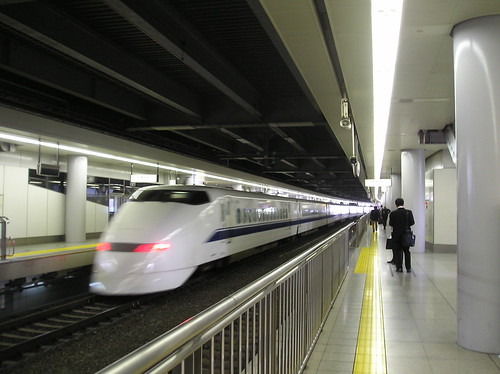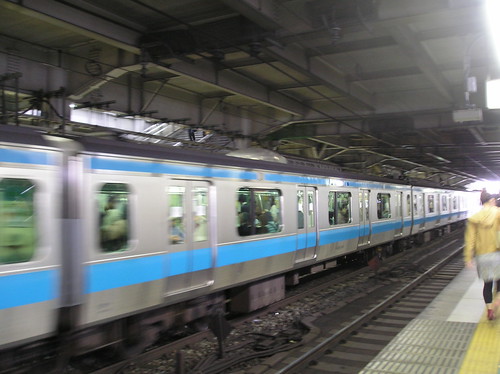We think it would be a big deal to have a high-speed rail line from Los Angeles to San Francisco. But the Shinkansen (still nicknamed "bullet train" after the original bullet-nosed trains) starts on the island of Kyushu, tunnels from Kyushu to Honshu, continues up through Hiroshima to Osaka, Kyoto and Nagoya, reaches Tokyo and continues north to Sendai and Akita prefecture. An extension to Aomori is scheduled to open in December with a branch to Hokkaido planned beyond that.
In addition, there is the Yamagata Shinkansen through the mountains, the Joetsu Shinkansen to Niigata and the Nagano Shinkansen, which connects the site of the 1998 Winter Olympics with Tokyo.
 |
| Shinkansen at Shinagawa, from my Flickr account |
Creating a Shinkansen in California would require not just Los Angeles to San Francisco, but the Bay Area to Sacramento, Sacramento to Reno, Los Angeles to Las Vegas, Los Angeles to San Diego and maybe even a few other branches. (Sacramento to Redding? Los Angeles to Palm Springs?)
And that would be just the tip of the iceberg. Because most of Japan's intercity trains are electric and they go just about everywhere. Such as this secondary train to Kameoka , outside of Kyoto.
So, Monterey might not be on the Cal HSR station list. But it would have an all-electric commuter rail connection to San Jose or San Francisco. The diesel trains of Amtrak's Pacific Surfliner would be replaced by a faster, electric version. Towns such as Porterville and Visalia would be linked to the nearest HSR stations in Hanford or Fresno.
One level below that would be commuter trains. In Tokyo and elsewhere in Japan, the line between commuter train and subway is blurred, as a train which looks like this:
 |
| a JR Keihin-Tōhoku Line train |
could be either a subway train or a commuter train. Commuter trains are a big business in Japan, and private railway companies compete with Japan Railways (JR).
Impossible, you say? We certainly lack the funding for such an extensive network of continuous trains. But, given our traffic problems, growing population, smog and pollution and shrinking supplies of gasoline, it's certainly a goal worth aiming towards.
No comments:
Post a Comment